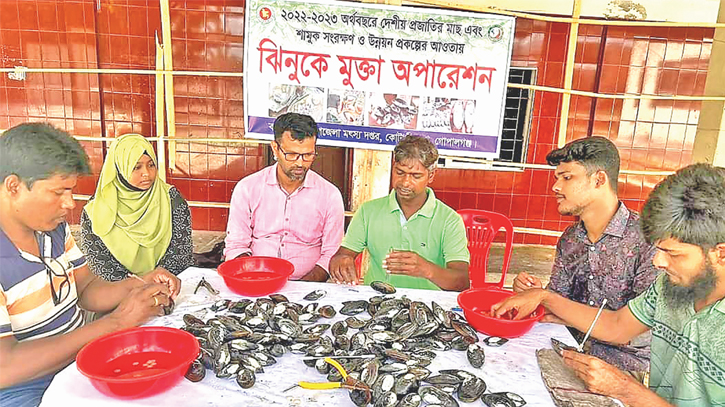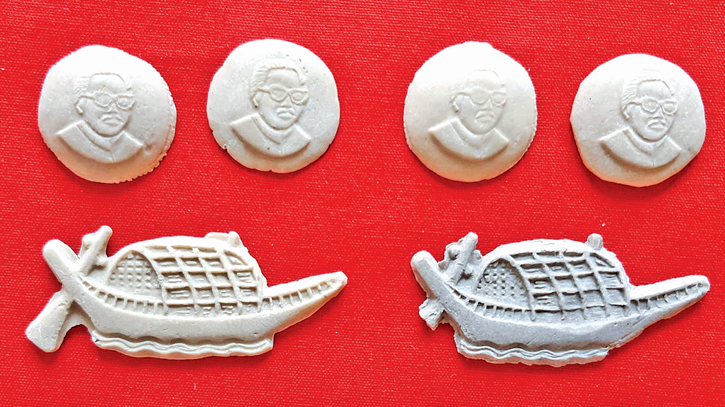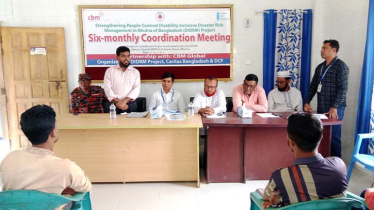
The pearl farming venture initiated by Nazrul Islam has garnered significant attention from educated, unemployed youths. (Inset) A collection of ornaments, adorned with pearls depicting the portrait of Bangabandhu. PHOTO: TDM
Pearl farming is opening up exciting pathways to success in in Jhenaidah, attracting numerous youths to embrace this innovative form of aquaculture. Traditionally, commercial pearls seen in markets are cultivated by farmers in ponds, and they can also be grown in larger drums or tanks.
One remarkable individual, Dr Nazrul Islam, an agricultural entrepreneur, has achieved extraordinary success by integrating pearl cultivation with fish farming in Jhenaidah. His visionary project has not only brought him personal achievements but has also generated valuable employment opportunities for the local community.
The pearl farming venture initiated by Nazrul Islam has captured the interest of educated unemployed youths in the area due to its high profitability, despite requiring only small plots of land. Recognizing its potential, the entrepreneur believes pearl farming could emerge as a thriving industry in the region.
Hailing from Shivnagar village in Kotchadpur upazila, Dr Nazrul started with a background in Zoology from Rajshahi University, he pursued higher education and obtained a PhD degree from the same university. Later, he went to Japan, where he earned a Doctor of Science degree from Shizuoka University.
 Establishing his project, covering approximately 10 bighas of land, Nazrul focused on organic agriculture, producing poison-free vegetables and fruits. He later diversified into fish and pearl farming in two of the project's ponds.
Establishing his project, covering approximately 10 bighas of land, Nazrul focused on organic agriculture, producing poison-free vegetables and fruits. He later diversified into fish and pearl farming in two of the project's ponds.
The innovative approach of cultivating designer pearls with fish as a pilot project has proven successful. Within a year, Nazrul managed to cultivate around 2,000 pearls of different designs, valued at approximately Tk 5 to 6 lakh. With an additional 3,000 oysters in his pond, he expects to collect pearls worth Tk 7 to 8 lakh.
Notably, Dr Nazrul Islam made history by crafting a portrait of Bangabandhu Sheikh Mujibur Rahman using cultivated pearls among oysters.
Elaborating on the process, he explained that it takes 7 to 8 months for pearls to form inside oysters after embedding designs made from calcium carbonate powder. Remarkably, two designs can be cultivated in a single oyster without incurring extra costs, allowing for coexisting fish farming in the same pond.
Dr Nazrul's success has inspired other local youths to take up pearl farming. His pearls have gained recognition, receiving an A-grade rating and attracting interest from a reputable company in Dhaka.
As the momentum for pearl farming grows, Samchiku Kumar, the Senior Fisheries Officer of Kotchadpur Upazila, confirmed that approximately 100 educated youths have undergone training on pearl farming, supported by the Bangladesh Fisheries Research Institute. This indicates the potential for pearls to contribute significantly to Bangladesh's economy, provided a robust market is established.
Looking ahead, Nazrul Islam is optimistic about the future of pearl farming in Bangladesh and has pledged full technical cooperation to any interested youth in the country.
TDM/SD








